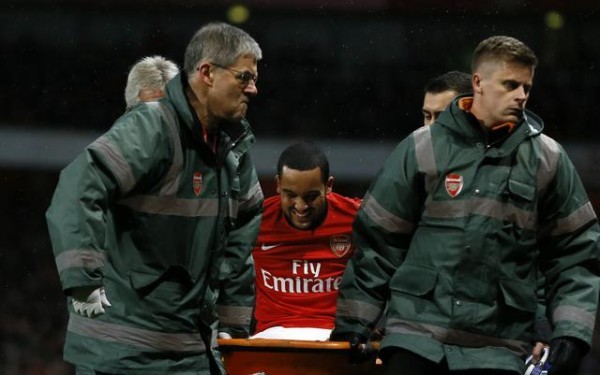Arsenal suffered a huge blow this month after their star winger Theo Walcott was ruled out for rest of the season due to an Anterior Cruciate Ligament (ACL) injury.
It is one of the most common injuries in football and the consequence of the injury can be devastating at times, with Chelsea’s Michael Essien a good example, as the Ghanaian ruptured his ACL, and has not been the same player since.
In case of Walcott, there is a genuine fear that the England superstar might miss the World Cup trip to Brazil.
Here, we take a look at what an ACL injury all about, how it occurs and how the rehabilitation process should be taken care of.
About Anterior Cruciate Ligament
It is basically a form of knee injury. Anterior Cruciate Ligaments provide stability to the knee joint. It is essential in controlling the pivot movements and an injury to this area mostly occurs with people associated in sports which involve fluid movements like cutting, turning and changing directions.
Football & ACL
It is an injury that is quite common in football, as the use of the knee is pivotal. Stats show that for every 100 hours of game play, there are between 4 and 7 Anterior Cruciate Ligament injuries. Since professional football is becoming more intense day by day, with more and more games played now than ever before, the chances of this injury are higher than ever. Over the last 15 years, there has been a 172% increase in ACL injuries, which reflects the growing demands of the game.
How the injury occurs
The injury can occur though contact or non-contact mechanisms. About 68-72% of injuries arise through non-contact mechanisms like players landing awkwardly on one leg following a jump or change in direction with a side stepping movement.
It must be noted that ACL may not occur alone – other structure of the lower body parts can also be damaged during such incidents like medial collateral ligaments, the menisci, the articular cartilage surface and bone bruising. Further, the risk of developing knee osteoarthritis later on in life goes hand-in-hand with this type of injury.
Surgery may be needed
Surgery may be needed once an accurate diagnosis has been made. A bundle borrowed from the players own hamstrings or patella-tendon is used to replace the anterior cruciate ligament. This is a common surgical process and the player may return to the same level of fitness as before, but the rehabilitation period is long and arduous.
Rehabilitation
It generally takes six months for good athletes and longer for non-elite athletes to fully recover from surgery.
Good rehabilitation is absolutely essential in allowing the patient to perform at levels previously achieved prior to injury. The first steps of rehabilitative physiotherapy involve static contractions of the hamstrings and joints, as well as small movements with the aid of a weight-bearer (i.e. crutch). This would be introduced slowly so as to minimise pain and swelling. These first steps aid psychological well-being, and slowly enables the patient to regain control of the quadriceps, and allows for the removal of the post-operative brace (usually after three to four weeks).
Proprioception is a key aspect of rehabilitation, as it allows for a speedier recovery, an improved reaction-time, and it also decreases the chances of re-injury. It is introduced as part of the program as soon as is possible.
Later phases focus on increasing the range of motion, specific exercises on the affected leg, cycling and pool work, general strengthening or muscles, and gaining hamstring and quadriceps control. Final phases place emphasis on specific sports exercises that replicate actual game play, as well specific agility training, and endurance.
Role of St George’s Park
The rehabilitation process performed at St. Goerge’s’ Park not only ensures the athlete a return to game-play successfully, but also allows for foundations to be laid to lower the potential for future injury.
FIFA are also working actively on the prevention of ACL and have introduced the 11+ programme aimed at players aged 14 and over.
Reference list:
FA., (2006) Shear class, thefa.com
http://www.thefa.com/England/SeniorTeam/NewsAndFeatures/Postings/2006/04/England_Shearer.htm
FIFA., (2006) How footballers are brought to their knees, fifa.com
http://www.fifa.com/en/development/medical/index/
Majima, et al (2002) Rehabilitation after hamstring anterior cruciate ligament reconstruction, Clinical Orthopaedics and Related Research. Vol; 397: 370-380.
Prodromos et al (2007)
http://www.arthroscopyjournal.org/article/S0749-8063(07)00686-X/abstract
http://f-marc.com/11plus/exercises/
Add Sportslens to your Google News Feed!
